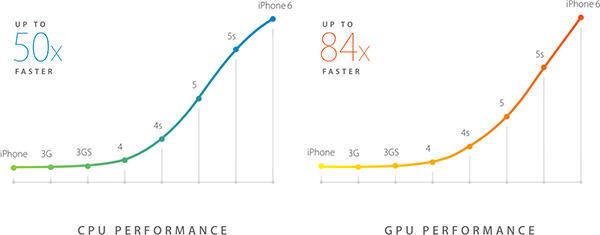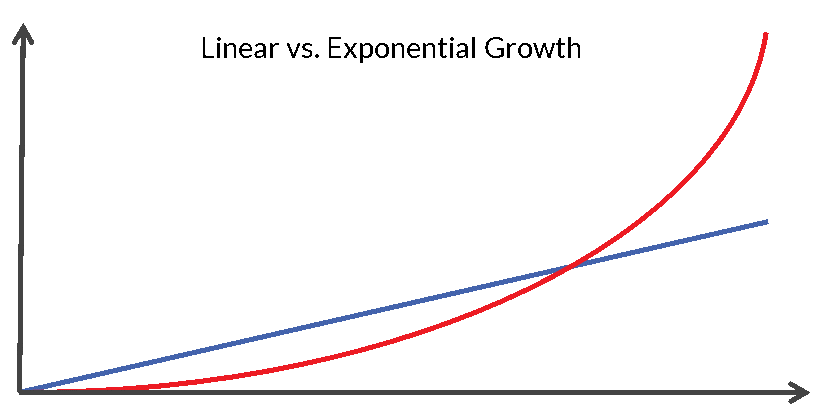Exponential Change due to Exponential Growth
The fast changing world of technology is also impacting the way how industries are doing business
Exponential Growth is a very important aspect of technology but also businesses. When we look at the pace of technology, we soon see why so many companies are struggeling to keep up.
Index
Exponential Change explained
The whole world is getting faster, and technology is the pacemaker of our change. But why are so many people talking about this rapid change? “Exponential change” or “exponential growth” are two phrases that sum up what is happening in the world of technology. I want to give a little insight into how this works and why this exponential growth is now accelerating remarkably. We also need to understand the implications for our society and, in particular, for business.
Difference between linear and exponential growth
It is a bit difficult for us humans to think in exponential numbers. We usually work in a linear way, counting from 1, 2, 3, 4, 5… and so on. If we ask someone what number comes after 9, they will probably tell us 10.
When we talk about exponential numbers, we have to give an example. 1, 2, 4, 8, 16, 32, 64, etc. But if you ask someone what 2 to the power of 10 (2^10) is, most people would not be able to tell you that 2^10 = 1024. We humans think differently, but computers can do this thinking at any time, and we see these exponential increases everywhere. Whether it is viruses, platforms, algorithms or anything else.
 Why is exponential growth so important?
Why is exponential growth so important?
Only in recent times, we were able to see the impact of exponential systems in our daily life. A good example was the first iPhone. It was released in 2007 and was a technological powerhouse in our pockets. 2014, just 7 years after, the iPhone 6 was released and had 50 times the CPU performance and more than 84x the graphic acceleration power. I mention this as within the 7 years on average the iPhone was twice as powerful as the year before.

iphonehacks
But the iPhone is just one example. Every processor, every computer, every system follows the same pace, and every year it gets faster and faster as technology develops and becomes more powerful.
This basic understanding is so important because we are now in a phase where technology is gaining ground in every area of our daily lives. Especially when it comes to business impact and the technology available. We are starting to see a proliferation of solutions and exponential growth in many areas of business. These opportunities and challenges need to be addressed.
Exponential growth in business
When it comes to business and business technologies, we see the same picture. Every year we get hundreds of new technologies that we can use to invent new products, develop new services, optimise processes or even interact with each other. This rapid technological change will also affect the way we do business, as it becomes more and more important how we deal with this rapid change and this exponential growth in computing power and resources. Even today, digital transformation is about 95% transformation and only 5% digital, as there are so many solutions available that ‘digital’ technologies are becoming commodities.
Companies are finding it increasingly difficult to maintain their business model with an “old economy” mindset. Rapidly changing environments and rapidly evolving opportunities need to be reflected in the culture and organisation itself.
A good example of a company dealing with this rapid change is Amazon. While they are constantly changing their core business model and adapting to new technologies, they are able to innovate in different areas when they see a demand for it. Rapid adoption and implementation are some of Amazon’s key success factors for most of its businesses. They see a problem and try to use the latest technology to improve the experience. A very well-known innovation was the self-checkout supermarket.
Scalability is (often) key for future success
If we look at Amazon as an example, we also see that they have been able to scale their business model with the help of technology. This so-called scalability is a very important aspect of digital business models. Basically, it means that the more you sell, the more you can deliver per unit. If, for example, as a consultant you charge one hour for every hour invested, this is a non-scalable business model. A scalable business model, on the other hand, would be an app. You programme it once and then don’t have to invest any more hours, but you get the revenue. The effort for maintenance and development does not grow proportionally to the revenue you generate with the app, because the app can have an unlimited number of users who potentially generate unlimited revenue, while your costs remain the same no matter how many people download and use your app.
Examples
Of course, there are hundreds of examples and various industries that are undergoing this transformation. Here I deliberately only mention 3 examples, because otherwise, the list would be too long.
- Consulting Companies: The non-scaling business model of many consulting companies is the reason for many to expand into the digital field. They are looking for software and other solutions that can scale and don’t necessarily need so many highly skilled workers.
- Pharma & Healthcare: Another example it’s the pharmaceutical or medical industry. Usually, it involved production and lots of human resources (e.g. patient care) but with robotics, software-guided medicine, and also AI-supported diagnostics this is a huge market for these classical industries to expand into.
- Fitness Industry: Everybody knows the fitness trainer in the gym. But this is a classical example of a non-scaling business model. So many fitness-start-ups are looking into expanding into personalized but only online training models. One example is Freeletics.
The challenges of exponential growth
Exponential change also brings its own challenges. While the exponential growth of technology offers opportunities for innovation, efficiency and new companies/business models, it also presents us with major challenges that we need to overcome. Here are some of the key challenges of exponential growth for businesses and society:
- Ethical and data privacy concerns: The rapid development and use of technologies, especially those that collect and analyze data, raise significant ethical and privacy issues. The more AI and machine learning are integrated into everyday life, the greater the potential for the misuse of personal data.
- Cybersecurity risks: The exponential growth of technology also means exponential growth in the complexity and potential vulnerability of systems. Society and the economy are becoming dependent on digital infrastructure – making it a perfect target for hackers. The challenge is to stay one step ahead of cyber threats, which are evolving as fast as the technologies they seek to exploit.
- Economic displacement and the skills gap: Technological advances can lead to the displacement of workers or their skills when automation and AI replace human workers in certain sectors or tasks. This creates a skills gap where the demand for new technology-related skills outstrips the supply of trained professionals. Addressing this challenge will require a concerted effort by governments, educational institutions and businesses to revise curricula, promote lifelong learning and provide retraining opportunities so that the workforce can adapt quickly – but at some point we will also have a surplus of workers, leading to a digital divide.
- Growing digital divide: The world is not equally sharing the benefits of exponential technological growth. There is a risk of a widening digital divide between those who have access to the latest technologies and those who do not. This gap can exacerbate existing inequalities and hamper economic and social development in less technologically advanced regions. For example, billions of people still do not have reliable access to the Internet, and some of the new technologies are too expensive for most people around the world.
Change is the only constant
The key to long-term business success has always been, and still is, speed of adoption and responsiveness to environmental change. As the exponential trend in technology accelerates the market and the need for adoption, this rapid adoption into new areas and new businesses is becoming more and more critical. To survive in any domain, a new mindset is needed that reflects the constant change paradigm in the organisation. The better the culture of change and trial and error, the easier it will be to take a leading position in the market and to use exponential growth for your own development.

 Why is exponential growth so important?
Why is exponential growth so important?
Comments are closed.